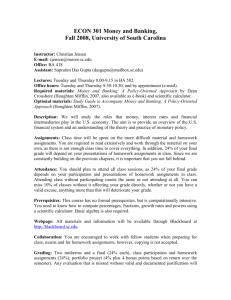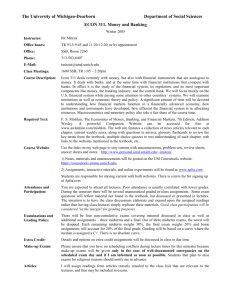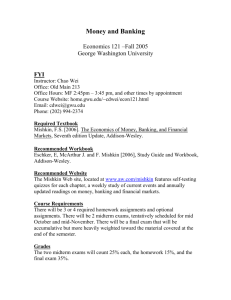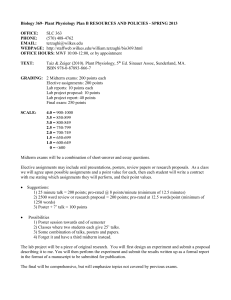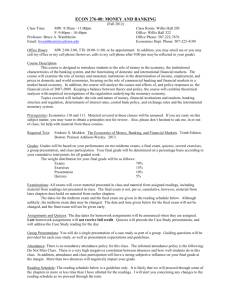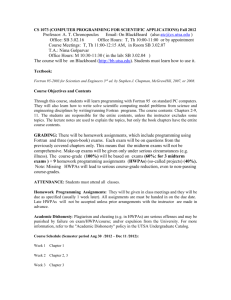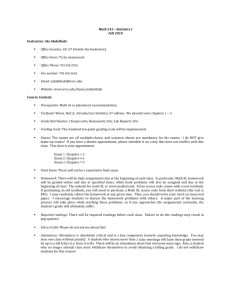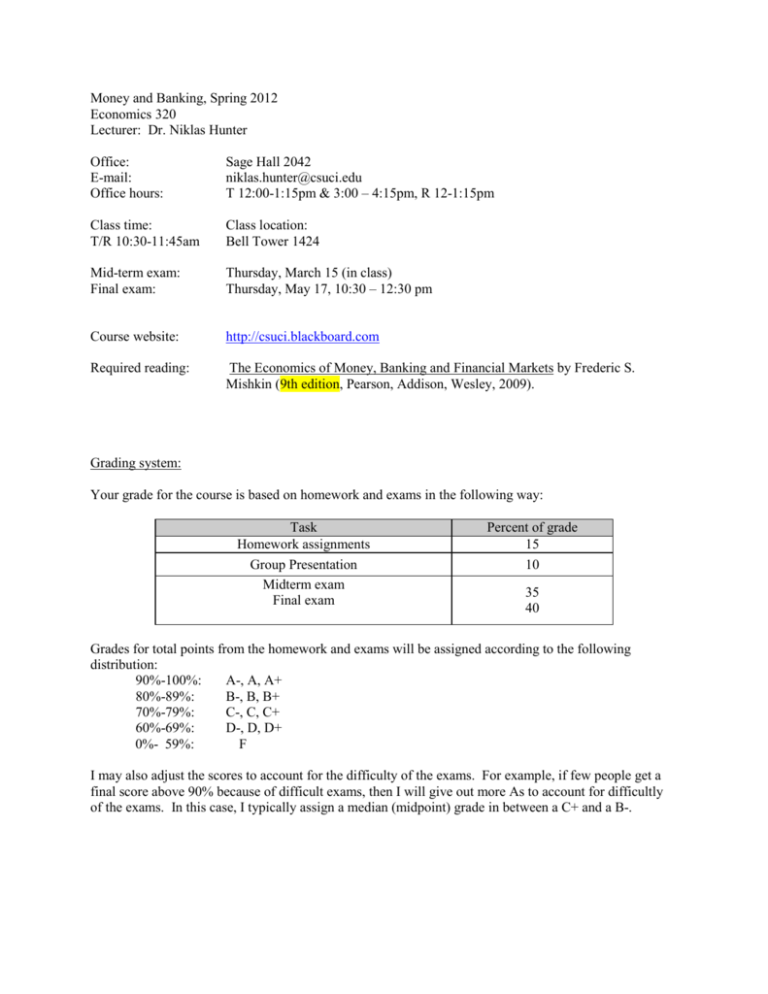
Money and Banking, Spring 2012
Economics 320
Lecturer: Dr. Niklas Hunter
Office:
E-mail:
Office hours:
Sage Hall 2042
niklas.hunter@csuci.edu
T 12:00-1:15pm & 3:00 – 4:15pm, R 12-1:15pm
Class time:
T/R 10:30-11:45am
Class location:
Bell Tower 1424
Mid-term exam:
Final exam:
Thursday, March 15 (in class)
Thursday, May 17, 10:30 – 12:30 pm
Course website:
http://csuci.blackboard.com
Required reading:
The Economics of Money, Banking and Financial Markets by Frederic S.
Mishkin (9th edition, Pearson, Addison, Wesley, 2009).
Grading system:
Your grade for the course is based on homework and exams in the following way:
Task
Homework assignments
Group Presentation
Midterm exam
Final exam
Percent of grade
15
10
35
40
Grades for total points from the homework and exams will be assigned according to the following
distribution:
90%-100%:
A-, A, A+
80%-89%:
B-, B, B+
70%-79%:
C-, C, C+
60%-69%:
D-, D, D+
0%- 59%:
F
I may also adjust the scores to account for the difficulty of the exams. For example, if few people get a
final score above 90% because of difficult exams, then I will give out more As to account for difficultly
of the exams. In this case, I typically assign a median (midpoint) grade in between a C+ and a B-.
Exams:
There will be no make-up exams, so if you can not attend class on the day of the midterm or the final
exam, please do not enroll in this course.
The mid-term exam will cover all material up through the preceding lecture. The final exam questions
will be drawn almost exclusively from material presented after the midterm. The exams will include both
multiple choice and short answer questions based on the lecture notes and assigned reading.
Homework assignments:
There are six homework assignments that typically consist of 15 multiple choice questions drawn from
the same test bank I use for the exams. Homework assignments must be turned before lecture begins on
the specified dates of the course schedule. Late homework will not be accepted. I will, however, drop
the lowest score. As such, please do not be concerned about the effect on your course grade of missing a
single homework. I understand that over the course of 16 weeks, unexpected events can occur (illness,
work, family issues), and dropping your lowest homework score is my way of accounting for these
events. Unless instructed otherwise, the homework assignments must be turned in via blackboard on the
assignments tab. If you are new to blackboard, please don’t be concerned about this technical issue. I
will provide a brief tutorial on how to download an assignment from blackboard and how to turn it in via
blackboard as well.
Group Presentations:
Students should form a group of up to 3 members and select a single chapter from the list on the course
schedule. Each group will present review session material for either the midterm or the final exam. Your
groups’ presentation will occur in lecture on either March 13th (the lecture before the midterm) or on
May 10th (the lecture before the final exam). The presentation should be approximately 10-15 minutes,
and should include visual aids. Which date you present (March 13th or May 10th) depends on the chapter
your group selects. The chapters are available on a first come- first serve basis. The presentation is
mandatory, and the group members and the chapter must be selected by the end of the 3rd week of the
Semester. Past examples include Jeopardy style games, PowerPoint presentations with a pop quiz,
crossword puzzles, and movies (to name a few). The idea for this presentation is for you (and your group
members) to become experts on your selected chapter, and help your classmates prepare for the associated
exam by presenting the material in an interactive method.
Course Overview:
This course provides a thorough overview of financial institutions and monetary policy in the US. We
will consider the effect of money, interest rates, and bonds on various economic indicators. Other major
topics include: the importance of regulating the banking system, the tools of monetary policy, and the
major contributing factors to the most recent financial crisis. Note, the material from chapters 4 and 5 is
essentially “Present Value” (i.e. the time value of money). If you have previously taken a finance course,
this will be review material.
This course material is composed from a mix of both economic theory and applications.. The theory is
intended to give you a methodical way to grasp the mechanics of the banking system as a whole, while
the applications are intended to assist you in making sound financial decisions.
Learning objectives: At the end of this course, students should be able:
•
•
•
•
•
•
•
•
to define money and to understand its use
to calculate interest rates for simple present value equations.
to predict how interest rates change in response to various changes in the economy
to explain the events that led to the subprime crisis
to understand the importance of regulations in the banking system
to explain the various functions and roles of the Federal Reserve
to explain how banks create money without actually printing currency
to predict how monetary policy influences inflation, production and employment
Cheating:
Don't cheat. Any case of cheating, including looking at another student’s test booklet while taking an
exam will be referred to Judicial Affairs. Working with fellow students on homework assignments,
however, is not cheating and is encouraged.
Disability Accommodations:
Cal State Channel Islands is committed to equal educational opportunities for qualified students with
disabilities in compliance with Section 504 of the Federal Rehabilitation Act of 1973 and the Americans
with Disabilities Act (ADA) of 1990. The mission of Disability Accommodation Services is to assist
students with disabilities to realize their academic and personal potential. Students with physical,
learning, or other disabilities are encouraged to contact the Disability Accommodation Services office at
(805) 437-8510 for personal assistance and accommodations.
Please see next page for Course Schedule.
Course Schedule: Subject to changes as necessary through the semester. For example, I may push a HW
due date back, but never forward. The exam dates and review session dates will not change.
Date
24 Jan.
26 Jan.
31 Jan.
2 Feb.
7 Feb.
9 Feb.
14 Feb.
16 Feb.
21 Feb.
23 Feb.
28 Feb
1 March
6 March.
8 March
13
March
15
March
20
March.
22
March
27
March
29
March
3 April
5 April
10 April
12 April
17 April
19 April
26 April
1 May
3 May
8 May
Lecture topic
Why study money, banking,
and the financial markets
An overview of the financial
system
An overview of the financial
system
What is money?
Understanding interest rates
Understanding interest rates
The behavior of interest rates
The behavior of interest rates
An Economic Analysis
of Financial Structure
An Economic Analysis of
Financial Structure
Banking and the
Management of Financial
Institutions
Banking and Management
Financial Regulation
Economic Analysis of
Financial Regulation
Economic Analysis of
Financial Regulation
Review Session
Midterm
Textbook reading
Chapter 1
HW Due
Chapter 2
Chapter 2
Chapter 3
Chapter 4
Chapter 4
Chapter 5
Chapter 5
HW1
Chapter 8
Chapter 8
HW2
Chapter 10
Chapter 10
Chapter 11
HW3
Chapter 11
Chapters 1, 2, 3, 4, 5, 8, 10
and 11
Chapters 1, 2, 3, 4, 5, 8, 10
and 11
Group Presentations
No Class: Spring Break
No Class: Spring Break
Banking Industry: Structure
and Competition
Banking Industry
Chapter 12
Financial Crisis
Financial Crisis
Movie: Too Big to Fail
Central Banks and the
Federal Reserve System
The Money Supply Process
The Money Supply Process
Tools of Monetary Policy
Tools of Monetary Policy
The Conduct of Monetary
Policy: Strategy & Tactics
The Conduct of Monetary
Policy: Strategy & Tactics
Chapter 9
Chapter 9
Chapter 12
HW4
Chapter 13
Chapter 14
Chapter 14
Chapter 15
Chapter 15
Chapter 16
Chapter 16
HW5
HW6
10 May
Review Session
17 May
Final Exam (10:30-12:30)
Chapters 9, 12, 13, 14, 15,
16, and 22
Chapters 9, 12, 13, 14, 15,
16, and 22
Group Presentations

